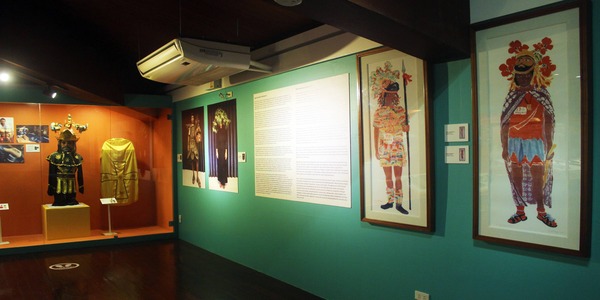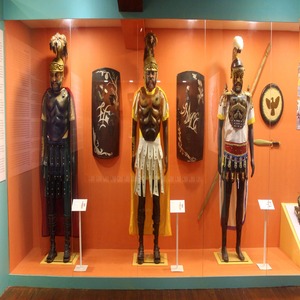| ‹ | Moryonan: Art and Devotion |
› |
|---|
The “Moryonan: Art and Devotion” highlights the tangible and intangible cultural heritage of the Province of Marinduque particularly, the moryonan or Moriones Festival, the art of headmask-making and other practices during Holy Week such as antipo and pupuwa.
Moryonan is a week-long religious practice participated by local penitents wearing full Roman soldier costumes with wooden masks under the heat of the sun. This shows their panata not only as an act of penance but also as a form of thanksgiving for good health, successful life, or bountiful harvest or catch.
Locals use the term moryon/morion, from the Spanish morrión (helmet), which is the full head mask worn by the participants.A moryon mask typically features a scowling face with big eyes and elaborate lashes, and open mouth. Usually oversized, the moryon is used not only to conceal the penitent’s identity, but also forms part of his or her annual expression of panata.
On exhibit are moryon masks from the National Ethnographic Collection which includes those gathered by the National Artist Alejandro Roces; full moryon garb consisting of upper and lower garments with cape, body armor, sandals, belt, sword/spear and shield; and, wood and different carving tools used by local artisans. Also on exhibition are the artworks of Mr. Claude Tayag, and photographs of Mr. Gabriel Malvar, researchers of the Ethnology Division and Marinduqueños.
An activity area for viewers is incorporated in the exhibition. Locals may post their photos on the board to contribute to the collection of moryonan photographs of the museum. Moryon mask tracing and coloring sheets are also available for students and viewers.
Moryonan to the Marinduqueños is a combination of art and devotion. It is primarily a solemn communal activity rather than a tourist attraction. The National Museum of the Philippines showcases this exhibition devoted to this enduring local tradition, to help safeguard and further understand this intangible heritage.
Moryonan: Art and Devotion is an exhibit in the National Museum Marinduque-Romblon, located in Boac, Marinduque, Philippines. The exhibit showcases the cultural and religious significance of the Moryonan festival, a Lenten tradition celebrated in Marinduque.
The Moryonan festival is known for its unique and colorful mask and costume designs, which depict the Roman soldiers of the biblical era. The exhibit features a collection of these masks and costumes, as well as other artifacts and artworks related to the festival.
Aside from the visual display, the exhibit also highlights the religious and cultural significance of the Moryonan festival. It features information about the origins of the festival and its connection to Catholicism, as well as the various rituals and traditions associated with it.
The Moryonan: Art and Devotion exhibit is known for its engaging and informative presentation of the Moryonan festival. It provides visitors with a deeper understanding of the cultural and religious significance of the festival, and the importance of preserving it for future generations.

.jpg)


